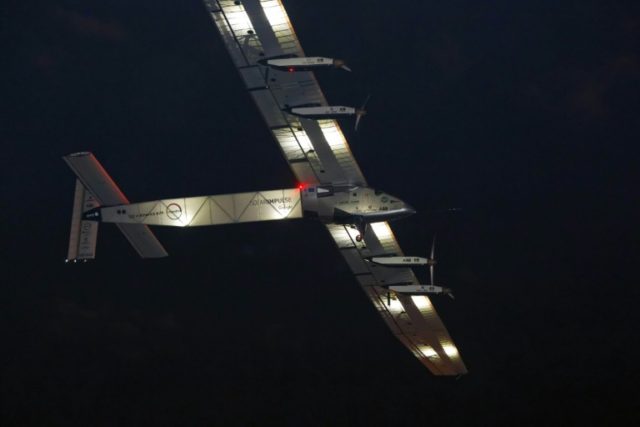New York (AFP) – The Solar Impulse 2 aircraft was flying over the western Atlantic Monday morning on one of the most difficult legs of its record-breaking bid to cross the globe using only solar energy.
The plane, which took off from New York’s JFK airport at around 2:30 am (0630 GMT), is piloted by Swiss adventurer Bertrand Piccard, who is expected to spend approximately 90 hours — during which he will take only short naps — crossing the Atlantic.
“It’s my first time taking off from JFK,” Piccard said over a live feed from the aircraft as he headed off into the night sky en route to Spain’s Seville Airport.
Several hours later he posted on Twitter that despite a previous full moon there is “now a pink sky in front of me, the day is waking up.”
The voyage marks the first solo transatlantic crossing in a solar-powered airplane and is expected to last four consecutive days and nights, depending on weather.
The plane, which is no heavier than a car but has the wingspan of a Boeing 747, is being flown on its 22,000-mile (35,000-kilometer) trip by two pilots taking turns, Piccard and Swiss entrepreneur Andre Borschberg.
“I’m in the cockpit this time, but we’re flying together,” Piccard told Borschberg before takeoff.
The pair have flown varying legs of the journey, with Borschberg piloting the flight’s final Pacific stage, a 4,000-mile (6,437-kilometer) flight between Japan and Hawaii.
The 118-hour leg smashed the previous record for the longest uninterrupted journey in aviation history.
The plane, now on the 15th leg of its east-west trip, set out on March 9, 2015 in Abu Dhabi, and has taken the aircraft across Asia and the Pacific to the United States with the sun as its only source of power.
– ‘Smooth takeoff’ –
“Smooth takeoff and all #Si2 systems have been checked here at the Mission Control Center for the #Atlantic Crossing,” Borschberg posted on Twitter soon after Solar Impulse 2’s departure.
Prince Albert of Monaco, a patron of the project, gave the flight the go-ahead from its mission control center in Monaco, telling Piccard “you are released to proceed.”
Approximately a third of the journey still remains for the plane, which will fly through Europe and on to Abu Dhabi after crossing the Atlantic.
The single-seat aircraft is clad in 17,000 solar cells. During nighttime flights it runs on battery-stored power.
“Solar Impulse is like a flying smart grid, and if we can make it work in an airplane, where we can’t cheat, we can make it work on the ground, in our cities, for our homes and for all applications,” Borschberg said in a statement.
The plane typically travels at a mere 30 miles (48 kilometers) per hour, although its flight speed can double when exposed to full sunlight.
“Best of luck on this wonderful adventure @bertrandpiccard & all the team,” British billionaire entrepreneur Richard Branson, owner of space tourism company Virgin Galactic, posted on Twitter.
Piccard and Borschberg are no strangers to adventure.
Piccard, a psychiatrist, made the first non-stop balloon flight around the world in 1999. Meanwhile, Borschberg only narrowly escaped an avalanche 15 years ago and in 2013 survived a helicopter crash with minor injuries.

COMMENTS
Please let us know if you're having issues with commenting.